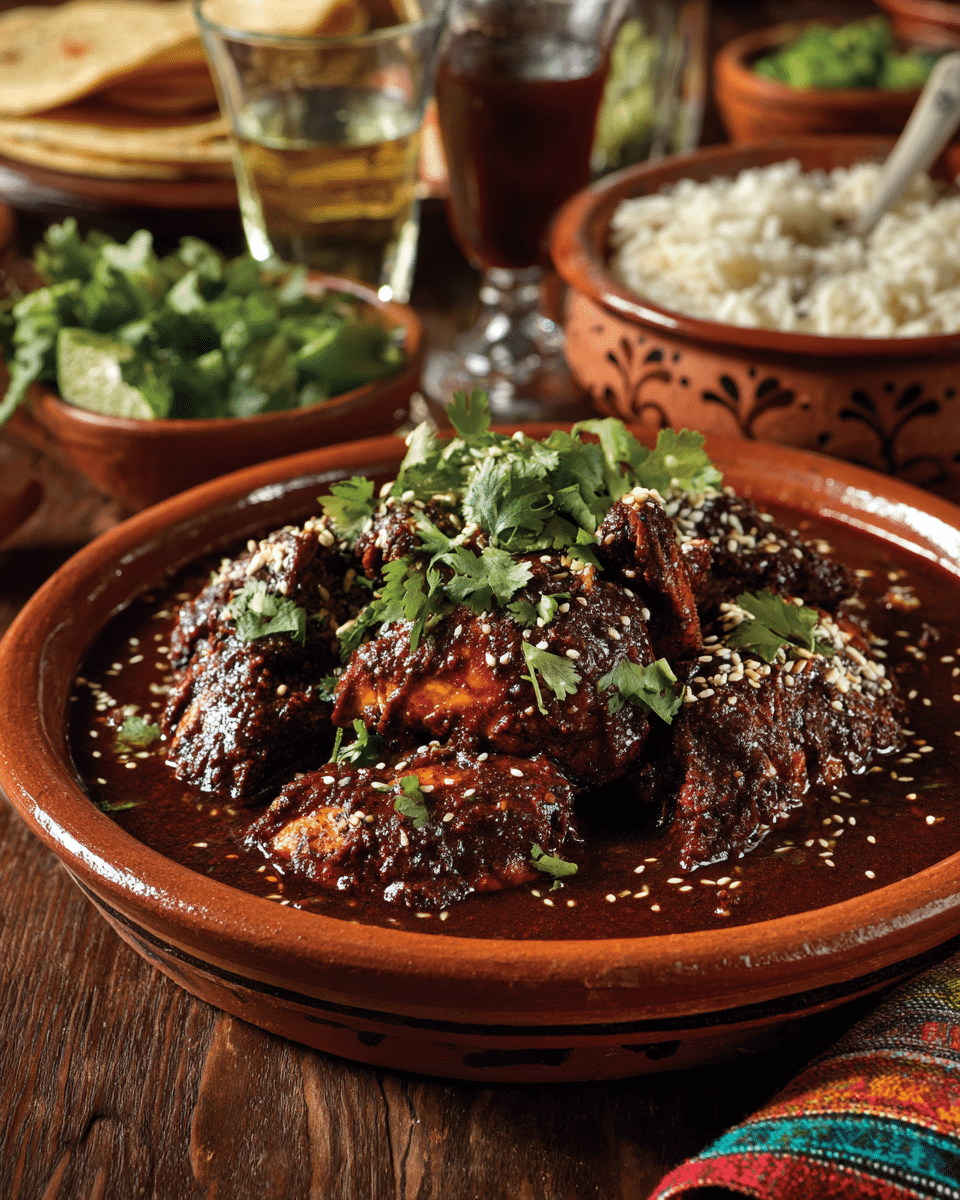Mole Poblano is one of Mexico’s most iconic and beloved sauces, famous for its complex blend of spices, chilies, and chocolate. This rich, deeply flavored sauce is traditionally served over chicken, offering a perfect balance of sweet, spicy, and savory notes. Originating from Puebla, mole poblano reflects centuries of culinary heritage, blending indigenous and Spanish influences into a dish that’s both celebratory and comforting.
FULL RECIPE
Ingredients
- 3 dried ancho chilies
- 3 dried pasilla chilies
- 2 dried mulato chilies
- 1 dried chipotle chili (optional for extra heat)
- 4 cups chicken broth
- 2 tablespoons vegetable oil
- 1 small onion, chopped
- 3 cloves garlic, minced
- 1 slice white bread, toasted
- ¼ cup almonds, toasted
- 2 tablespoons sesame seeds, toasted
- 1 small ripe tomato, roasted
- 1 tablespoon raisins
- 1 tablespoon pumpkin seeds
- 1 teaspoon ground cinnamon
- ½ teaspoon ground cloves
- 1 teaspoon dried oregano
- 1 tablespoon chili powder
- 1 ounce Mexican dark chocolate (or unsweetened chocolate)
- Salt, to taste
- 3 lbs chicken pieces (thighs and drumsticks preferred)
- Fresh cilantro and extra sesame seeds for garnish
Directions
- Remove stems and seeds from all dried chilies. Toast them lightly in a dry skillet over medium heat for about 1–2 minutes, being careful not to burn.
- Soak the toasted chilies in hot chicken broth for 20–30 minutes until softened. Reserve the broth.
- In a large pot, heat vegetable oil over medium heat. Sauté onion and garlic until soft and translucent, about 5 minutes.
- Add toasted bread, almonds, sesame seeds, pumpkin seeds, raisins, and roasted tomato to the pot. Cook for another 3–4 minutes, stirring frequently.
- Transfer the contents of the pot along with soaked chilies and some soaking broth into a blender. Blend until smooth, adding more broth if necessary to reach a thick sauce consistency.
- Pour the blended sauce back into the pot and simmer over low heat. Add cinnamon, cloves, oregano, chili powder, and salt. Stir well.
- Add the Mexican dark chocolate to the sauce and stir until melted and fully incorporated. Simmer for 15–20 minutes, stirring occasionally to avoid sticking.
- Meanwhile, season the chicken pieces with salt and cook them in a separate pan or boil until tender and fully cooked.
- Add the cooked chicken pieces to the mole sauce, coating them thoroughly. Simmer together for 10 minutes to allow flavors to meld.
- Serve hot, garnished with fresh cilantro and a sprinkle of sesame seeds, alongside rice or warm tortillas.
Nutrition Facts
- Calories: 450
- Protein: 35g
- Total Fat: 28g
- Saturated Fat: 7g
- Carbohydrates: 15g
- Fiber: 5g
- Sugars: 6g
- Cholesterol: 110mg
- Sodium: 350mg
Historical Significance of Mole Poblano
Mole Poblano is often regarded as Mexico’s national dish, with roots tracing back to the colonial era in Puebla. Its creation is attributed to a blending of indigenous ingredients like chilies and chocolate with European spices and techniques introduced by Spanish colonizers. The dish symbolizes cultural fusion and has become a culinary icon representing Mexican heritage, often served at festive occasions such as weddings, holidays, and religious celebrations. Its history reflects centuries of tradition, making it much more than just a sauce—it’s a representation of Mexican identity and pride.
Complex Flavor Profile
What makes mole poblano truly unique is its intricate balance of flavors—spicy, sweet, smoky, and earthy—all layered in one sauce. The combination of various dried chilies provides a mild to moderate heat with smoky undertones, while ingredients like chocolate, cinnamon, and raisins add depth and subtle sweetness. This harmony of taste challenges the palate, making each bite rich and unforgettable. The slow cooking process allows these flavors to meld together, resulting in a sauce that is thick, velvety, and intensely flavorful.
Ingredients That Define Mole Poblano
Mole poblano is distinguished by its wide array of ingredients, many of which are not commonly combined in everyday cooking. The use of multiple types of dried chilies—such as ancho, pasilla, and mulato—creates a layered chili base. Toasted nuts and seeds like almonds, sesame seeds, and pumpkin seeds contribute nuttiness and texture. The inclusion of dark chocolate is pivotal, adding bitterness and richness that balances the heat and spices. Together, these components create a sauce that is complex, nuanced, and emblematic of Mexican culinary artistry.
Health Aspects and Nutritional Value
Despite its indulgent taste, mole poblano contains many nutritious ingredients. Chilies are rich in vitamins A and C and contain antioxidants, while nuts and seeds provide healthy fats and protein. The chicken served with mole offers lean protein, essential for muscle maintenance. However, mole can be calorie-dense due to the use of oil, chocolate, and nuts, so portion control is advisable for those mindful of caloric intake. Overall, when enjoyed in moderation, mole poblano can be part of a balanced diet that celebrates both flavor and nourishment.
Traditional Preparation Techniques
Authentic mole poblano requires time and patience, often involving a lengthy process of toasting, soaking, blending, and simmering. Toasting dried chilies and nuts brings out their aromas and deepens flavors. Soaking the chilies softens them for blending into a smooth sauce, while slow simmering helps develop its rich texture. Traditionally, mole was prepared in large quantities, sometimes with a mortar and pestle or a molcajete, to fully integrate the ingredients. This hands-on preparation remains a labor of love and a communal activity in many Mexican households.
Variations Across Regions and Families
While mole poblano is a classic, there are countless variations depending on region, family traditions, and ingredient availability. Some recipes add different spices or fruits like plantains or prunes for sweetness. Others might incorporate additional chilies or use different types of chocolate, adjusting the balance of flavors to personal taste. Certain versions are thicker or thinner in consistency, and the choice of protein varies from chicken to turkey or even pork. This flexibility allows mole to evolve while still honoring its roots.
Serving Suggestions and Accompaniments
Mole poblano is most commonly served over chicken, but it also pairs beautifully with turkey, pork, or even roasted vegetables for a vegetarian twist. It is traditionally accompanied by Mexican rice and warm corn tortillas, which help soak up the flavorful sauce. Garnishes like sesame seeds and fresh cilantro add visual appeal and a hint of freshness. For a festive meal, mole can be served alongside side dishes such as refried beans or simple salads to complement the richness of the sauce.
Pairing Mole Poblano with Drinks
To enhance the dining experience, mole poblano pairs well with certain beverages that can stand up to its bold flavors. Traditional Mexican drinks like agua fresca—made from hibiscus, tamarind, or pineapple—offer refreshing acidity that cuts through the richness. Mexican beers or a glass of light red wine like Pinot Noir can also complement the sauce without overpowering it. For non-alcoholic options, lime-infused sparkling water provides a crisp palate cleanser between bites.
Storage and Reheating Tips
Mole poblano can be made in advance and stored in the refrigerator for up to 4 days, allowing the flavors to further develop. When reheating, it’s best to warm it gently over low heat to prevent the chocolate and spices from scorching. If the sauce thickens too much upon standing, adding a bit of chicken broth or water helps restore the perfect consistency. Leftover mole freezes well and can be thawed for quick meals, making it a convenient dish for meal prepping or busy weeknights.
Advertisement
Cultural Impact and Modern Adaptations
Mole poblano has inspired chefs and home cooks worldwide to explore Mexican flavors and techniques. Modern adaptations may deconstruct the sauce or incorporate unconventional proteins, but the essence of mole remains—a celebration of layered flavors and cultural heritage. It appears not only in traditional Mexican restaurants but also in fusion cuisine, elevating global palates with its complex taste. The enduring popularity of mole poblano reflects its timeless appeal and the pride Mexicans take in their culinary traditions.
Conclusion
Mole poblano is more than just a sauce; it is a symbol of Mexico’s rich culinary history and cultural identity. Its elaborate preparation and distinctive flavor profile make it a dish worth savoring on special occasions or whenever you want to experience the depth of Mexican cuisine. While it requires time and care to prepare, the reward is a sumptuous meal that brings warmth, tradition, and complexity to the table.






